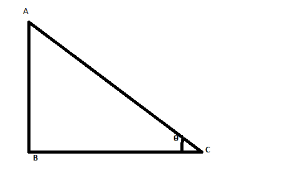
How is sin calculated?
Answer
530.7k+ views
Hint: In a right triangle, sin of an angle is the length of the side opposite to it divided by the length of the hypotenuse of the angle. i.e.
\[\sin (angle)=\dfrac{length \;of \;opposite \;side}{length \;of\; hypotenuse}\]
Complete step by step solution:
Consider a right angled triangle ABC such that

The sine of angle \[\theta \] is given as
\[\sin \theta =\dfrac{AB}{AC}\]
Here, as we can see in the figure , the side AB is called the perpendicular of the triangle and the side BC as the base whereas the side AC is called the hypotenuse of the triangle.
Therefore, we can write that
\[\begin{align}
& AB=P \\
& BC=B \\
& AC=H \\
\end{align}\]
Such that
\[\sin \theta =\dfrac{P}{H}\]
Formula used: An angle which forms the part of a right angled triangle, it is very easy to determine the sine function of that angle. The formula used to determine sine of an angle is
\[\sin \theta =\dfrac{P}{H}\]
Where, \[P\] is the perpendicular of the triangle and \[H\] is the hypotenuse of the triangle.
Additional information: The other trigonometric functions of the angle can be defined similarly; for example, the cosine of the angle is the ratio between the adjacent side and the hypotenuse, while the tangent gives the ratio between the opposite and adjacent sides
So, the correct answer is “ \[\sin \theta =\dfrac{P}{H}\] ”.
Note: It is very important to carefully recognize the three sides of the triangle. Confusing base with perpendicular can convert sine to cosine or vice versa. Similarly, taking the longest side only as the hypotenuse is very important. The value of \[\sin \theta \] lies in the range between the values \[\left[ -1,+1 \right] \] so if you get any value that is less than \[-1\] or more than \[+1\] denotes a calculation mistake.
\[\sin (angle)=\dfrac{length \;of \;opposite \;side}{length \;of\; hypotenuse}\]
Complete step by step solution:
Consider a right angled triangle ABC such that

The sine of angle \[\theta \] is given as
\[\sin \theta =\dfrac{AB}{AC}\]
Here, as we can see in the figure , the side AB is called the perpendicular of the triangle and the side BC as the base whereas the side AC is called the hypotenuse of the triangle.
Therefore, we can write that
\[\begin{align}
& AB=P \\
& BC=B \\
& AC=H \\
\end{align}\]
Such that
\[\sin \theta =\dfrac{P}{H}\]
Formula used: An angle which forms the part of a right angled triangle, it is very easy to determine the sine function of that angle. The formula used to determine sine of an angle is
\[\sin \theta =\dfrac{P}{H}\]
Where, \[P\] is the perpendicular of the triangle and \[H\] is the hypotenuse of the triangle.
Additional information: The other trigonometric functions of the angle can be defined similarly; for example, the cosine of the angle is the ratio between the adjacent side and the hypotenuse, while the tangent gives the ratio between the opposite and adjacent sides
So, the correct answer is “ \[\sin \theta =\dfrac{P}{H}\] ”.
Note: It is very important to carefully recognize the three sides of the triangle. Confusing base with perpendicular can convert sine to cosine or vice versa. Similarly, taking the longest side only as the hypotenuse is very important. The value of \[\sin \theta \] lies in the range between the values \[\left[ -1,+1 \right] \] so if you get any value that is less than \[-1\] or more than \[+1\] denotes a calculation mistake.
Recently Updated Pages
Why are manures considered better than fertilizers class 11 biology CBSE

Find the coordinates of the midpoint of the line segment class 11 maths CBSE

Distinguish between static friction limiting friction class 11 physics CBSE

The Chairman of the constituent Assembly was A Jawaharlal class 11 social science CBSE

The first National Commission on Labour NCL submitted class 11 social science CBSE

Number of all subshell of n + l 7 is A 4 B 5 C 6 D class 11 chemistry CBSE

Trending doubts
What is meant by exothermic and endothermic reactions class 11 chemistry CBSE

10 examples of friction in our daily life

One Metric ton is equal to kg A 10000 B 1000 C 100 class 11 physics CBSE

1 Quintal is equal to a 110 kg b 10 kg c 100kg d 1000 class 11 physics CBSE

Difference Between Prokaryotic Cells and Eukaryotic Cells

What are Quantum numbers Explain the quantum number class 11 chemistry CBSE




